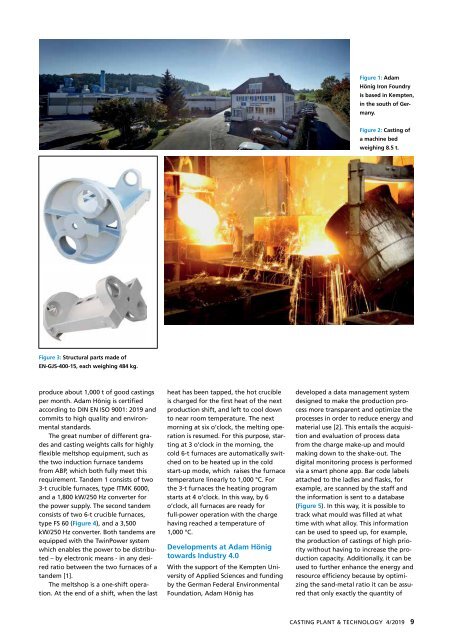CPT International 4/2019
Create successful ePaper yourself
Turn your PDF publications into a flip-book with our unique Google optimized e-Paper software.
Figure 1: Adam<br />
Hönig Iron Foundry<br />
is based in Kempten,<br />
in the south of Germany.<br />
Figure 2: Casting of<br />
a machine bed<br />
weighing 8.5 t.<br />
Figure 3: Structural parts made of<br />
EN-GJS-400-15, each weighing 484 kg.<br />
produce about 1,000 t of good castings<br />
per month. Adam Hönig is certified<br />
according to DIN EN ISO 9001: <strong>2019</strong> and<br />
commits to high quality and environmental<br />
standards.<br />
The great number of different grades<br />
and casting weights calls for highly<br />
flexible meltshop equipment, such as<br />
the two induction furnace tandems<br />
from ABP, which both fully meet this<br />
requirement. Tandem 1 consists of two<br />
3-t crucible furnaces, type ITMK 6000,<br />
and a 1,800 kW/250 Hz converter for<br />
the power supply. The second tandem<br />
consists of two 6-t crucible furnaces,<br />
type FS 60 (Figure 4), and a 3,500<br />
kW/250 Hz converter. Both tandems are<br />
equipped with the TwinPower system<br />
which enables the power to be distributed<br />
– by electronic means - in any desired<br />
ratio between the two furnaces of a<br />
tandem [1].<br />
The meltshop is a one-shift operation.<br />
At the end of a shift, when the last<br />
heat has been tapped, the hot crucible<br />
is charged for the first heat of the next<br />
production shift, and left to cool down<br />
to near room temperature. The next<br />
morning at six o’clock, the melting operation<br />
is resumed. For this purpose, starting<br />
at 3 o’clock in the morning, the<br />
cold 6-t furnaces are automatically switched<br />
on to be heated up in the cold<br />
start-up mode, which raises the furnace<br />
temperature linearly to 1,000 °C. For<br />
the 3-t furnaces the heating program<br />
starts at 4 o’clock. In this way, by 6<br />
o’clock, all furnaces are ready for<br />
full-power operation with the charge<br />
having reached a temperature of<br />
1,000 °C.<br />
Developments at Adam Hönig<br />
towards Industry 4.0<br />
With the support of the Kempten University<br />
of Applied Sciences and funding<br />
by the German Federal Environmental<br />
Foundation, Adam Hönig has<br />
developed a data management system<br />
designed to make the production process<br />
more transparent and optimize the<br />
processes in order to reduce energy and<br />
material use [2]. This entails the acquisition<br />
and evaluation of process data<br />
from the charge make-up and mould<br />
making down to the shake-out. The<br />
digital monitoring process is performed<br />
via a smart phone app. Bar code labels<br />
attached to the ladles and flasks, for<br />
example, are scanned by the staff and<br />
the information is sent to a database<br />
(Figure 5). In this way, it is possible to<br />
track what mould was filled at what<br />
time with what alloy. This information<br />
can be used to speed up, for example,<br />
the production of castings of high priority<br />
without having to increase the production<br />
capacity. Additionally, it can be<br />
used to further enhance the energy and<br />
resource efficiency because by optimizing<br />
the sand-metal ratio it can be assured<br />
that only exactly the quantity of<br />
CASTING PLANT & TECHNOLOGY 4/<strong>2019</strong> 9

















